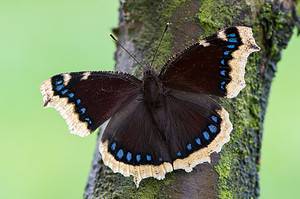Butterflies are small and beautiful, and they add splashes of color wherever they go. These tiny yet mighty creatures also have one of the most important jobs – helping nature thrive. Despite their importance in England, there are several butterfly species that are hard to spot. Some are elusive by nature while others are struggling to survive in threatened habitats. In this article, we will learn about the rarest butterflies fluttering around England. And if you’re lucky, you may have a chance to spot one.
How Common Are Butterflies in England?
There are 57 resident butterfly species in the United Kingdom and two migrant species that visit yearly. Various butterfly species commonly visit and pollinate gardens and other plant life around England. Unfortunately, most of these beautiful creatures only live for a few weeks. But adverse weather conditions, limited habitat space, and pesticides contribute to yearly dwindling numbers, making it hard to spot them even in good years. Butterflies are an integral part of the British ecosystem, therefore the decline in many species over the decades is a sign of a big problem.
The 8 Rarest Butterflies Fluttering Around England
Unfortunately, half of the wondrous butterfly species native to the U.K. are on the International Union for Conservation of Nature Red List of Threatened Species, or the Red List for short. But with the help of conservationists throughout the U.K., some of the rarest butterflies fluttering around England are returning in substantial numbers or have been spotted after years of extinction. All eight butterflies on this list come with unique physical features and lifestyles that set them apart from the other species.
Heath Fritillary (Melitaea athalia)
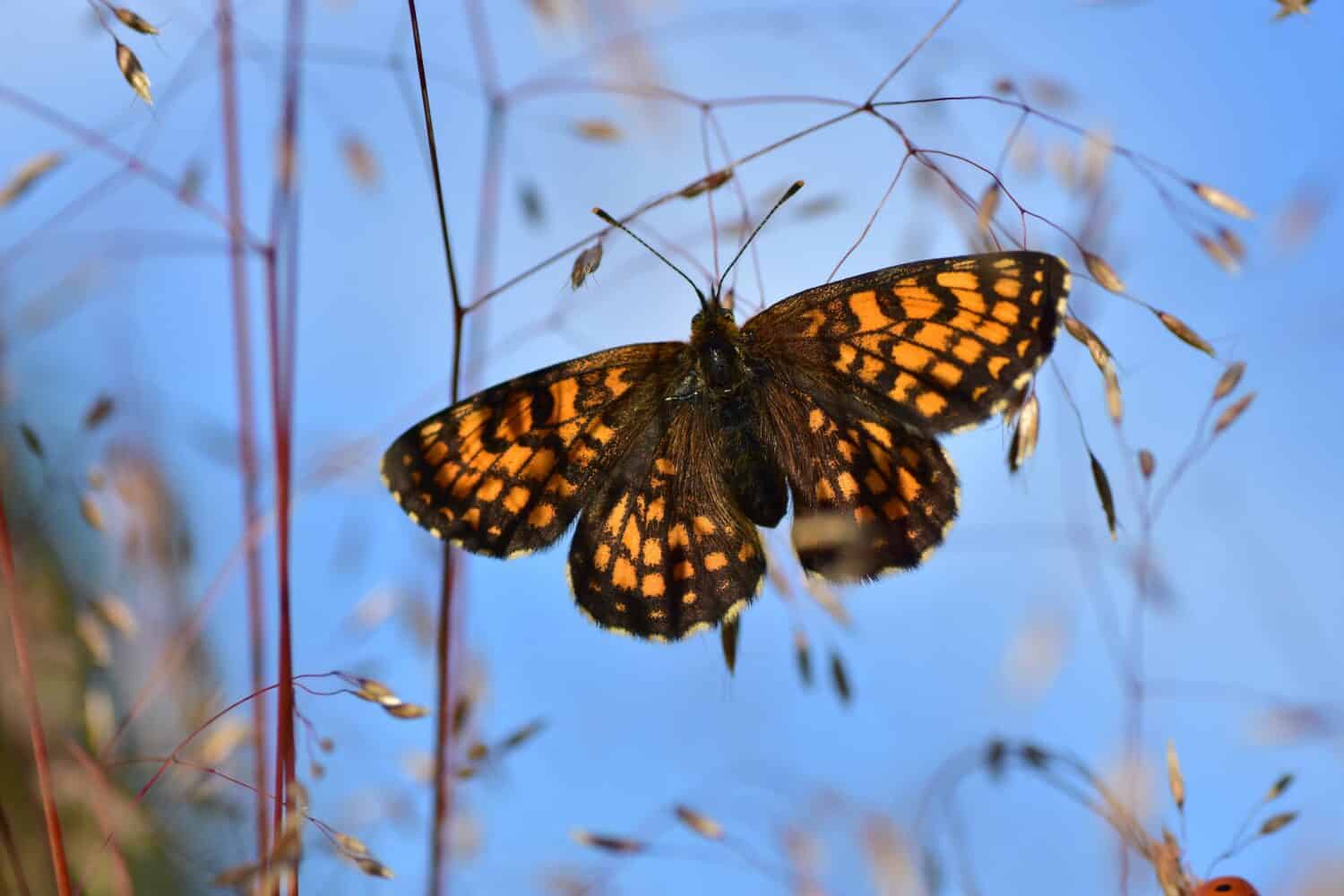
The heath fritillary was nearly extinct in England.
©Odeta Lukoseviciute/Shutterstock.com
The heath fritillary is one of the rarest butterflies fluttering around England. Although they are not considered threatened globally, they were saved from the brink of extinction in England through the help of decades-long conservation efforts. Now, they are considered a highly-threatened, priority species in the country.
This rare butterfly is a beautiful dusky brown and orange that resembles the Glanville fritillary, but the dark brown bands visible on the inside of their wings is what makes it easy to tell them apart. They also have white spots and a 1-2 inch wingspan.
Research about butterflies and habitat preservation is the reason they are slowly growing in numbers. To help numbers increase, they live in specialized habitats throughout the country. The heath fritillary lives in the woodlands or sheltered heathland of Devon, Somerset, Cornwall, Kent and parts of Essex. They don’t stray far from their breeding grounds but fly close to the ground in a distinctive pattern. The best time to see them is from May to July.
High Brown Fritillary (Argynnis adippe)
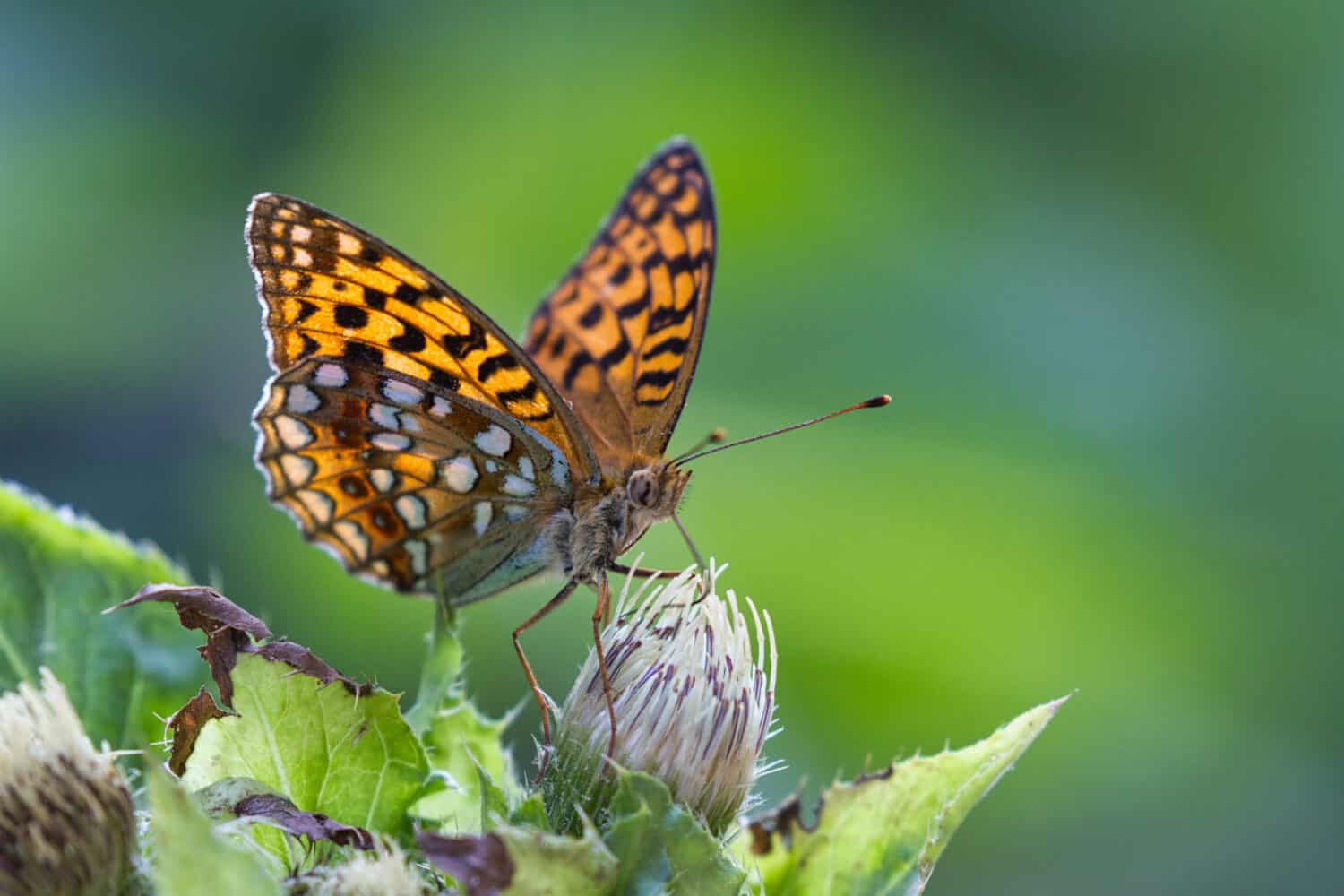
The high brown fritillary looks similar to the dark green fritillary.
©Paulina Wietrzy-Pelka/Shutterstock.com
The high brown fritillary is a rapidly declining species. One of the reasons for their decline since the 1970s is the lack of woodland coppicing, a traditional woodland management technique that involves cutting down trees into stumps to encourage new growth.
This fritillary species is easily mistaken for the common dark green fritillary because they frequently fly together on hillsides. But the high brown fritillary is easily distinguished by their 2-inch wingspan and inside wing markings that dot their dark orange and brown bodies. They also have a row of ocelli just before the outer margins of their wings.
The high brown fritillary was once commonly spotted throughout the woodlands of southern, central, and northwest England. Now they are only in Morecambe Bay, North and South Devon, and Exmoor, and have a single colony in Wales. It’s one of the rarest butterflies fluttering around England living on limestone rock outcrops in newly cleared areas. The best time to see them is from mid-June to late July.
Mountain Ringlet (Erebia epiphron)
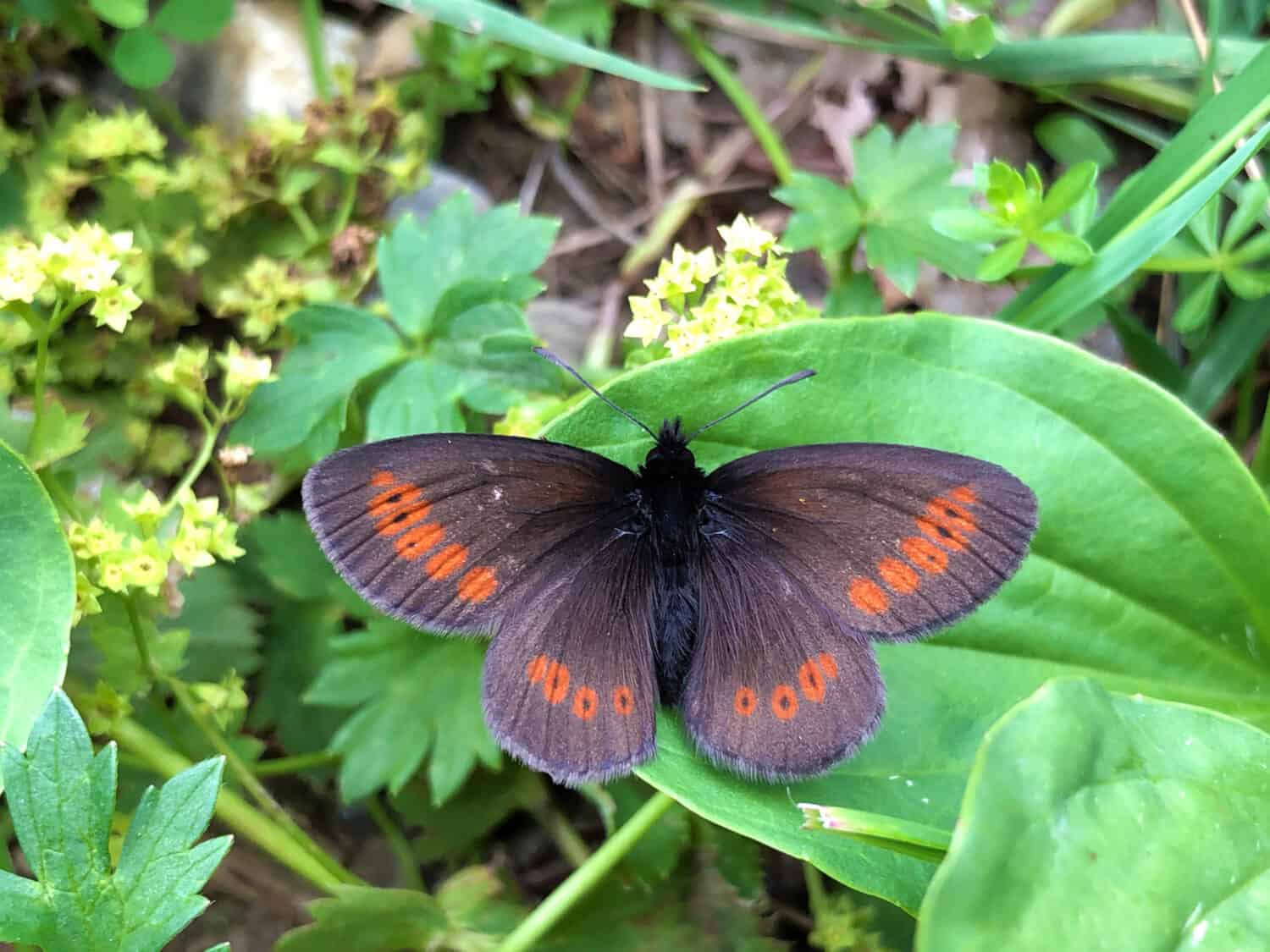
The mountain ringlet only lives in altitudes over 1,000 feet.
©Mario Krpan/Shutterstock.com
The mountain ringlet is a high-priority species in England. Although their numbers are stable, it’s difficult to assess their status because their habitat is too remote to easily travel. These factors, combined with their short flight period, make their well hidden colonies rare to spot.
As the name suggests, the mountain ringlet lives in the mountain grasslands at altitudes above 1,000 feet. Their appearance resembles the Scotch argus, which has white dots in the spots instead. They are dark brown with orange spots that have black centers. Moreover, their wingspan is 1.5 inches and they fly from late June to early August and live only 20 days.
In England, the mountain ringlet lives in the Lake District of Cumberland and Westmorland, in addition to western and central Scotland.
Brown Hairstreak (Thecla betulae)
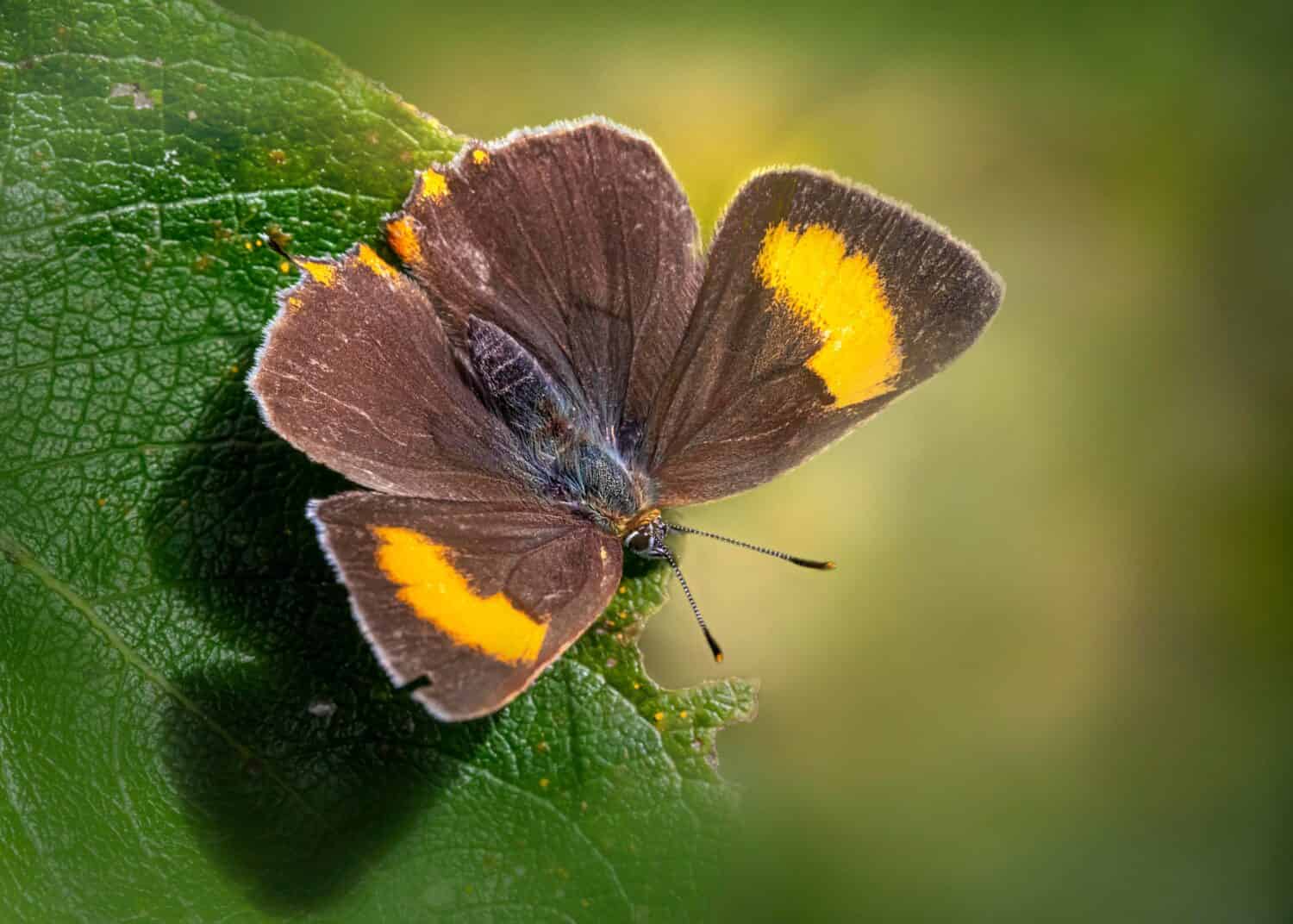
The brown hairstreak is the largest species of hairstreaks in the United Kingdom.
©Graphicato/Shutterstock.com
Brown hairstreaks are the largest species of hairstreaks in the U.K., with a wingspan of 1-1.5 inches. They are dark brown with a hard-to-miss orange mark on their front wings. On the other side of the wing, the color is dark orange. The adult brown hairstreak is elusive and difficult to spot without much luck and patience. They spend most of their time feeding on the sweetness of honeydew or aphids high in the trees. In fact, they rarely fly low enough to land on any flowers below unless it’s hot or rainy.
They are found in large ash, also called master trees, or in thick hedges. Those set on spotting these elusive butterflies have a higher chance of seeing them in areas in southern England from late July to November. By gently approaching an ash tree with binoculars, you may be lucky enough to spot a pair chasing each other around the tree.
The brown hairstreaks have experienced a decline of nearly 60% because of hedgerow removal and annual flailing, which removes the eggs. The female butterflies lay their eggs on the new growth of blackthorn often cut by tractor-mounted flails. Before, hedges were tended by hand, which was safer for the butterflies, and left cuttings for the subsequent laying season.
Large Blue (Phengaris arion)

The large blue butterfly was once extinct in England.
©Michal Pesata/Shutterstock.com
The large blue butterfly is the biggest and one of the rarest blue butterflies in England. The distinct row of black spots dotting the upper corners of their 2-inch blue wings set them apart. In contrast, their inside wings are pale brown with black spots.
The large blue butterfly was always rare in Britain until their extinction in 1979. However, they have been successfully reintroduced to southwestern England from continental Europe through conservation efforts that began in 1980. Unfortunately, their numbers are still declining worldwide.
This butterfly species is most known for its strange lifestyle, as they spend most of their time living in Myrmica ruba nests, also called European fire or red ants. In fact, young caterpillars spend their life cycle feeding on ant grubs. The ant grubs mistake the caterpillars for members of their nest and carry them inside. After eating the ant grubs, the large caterpillars become chrysalises. They live in warm grasslands, such as acidic coastal grasslands and limestone grasslands.
Adonis Blue (Polyommatus bellargus)
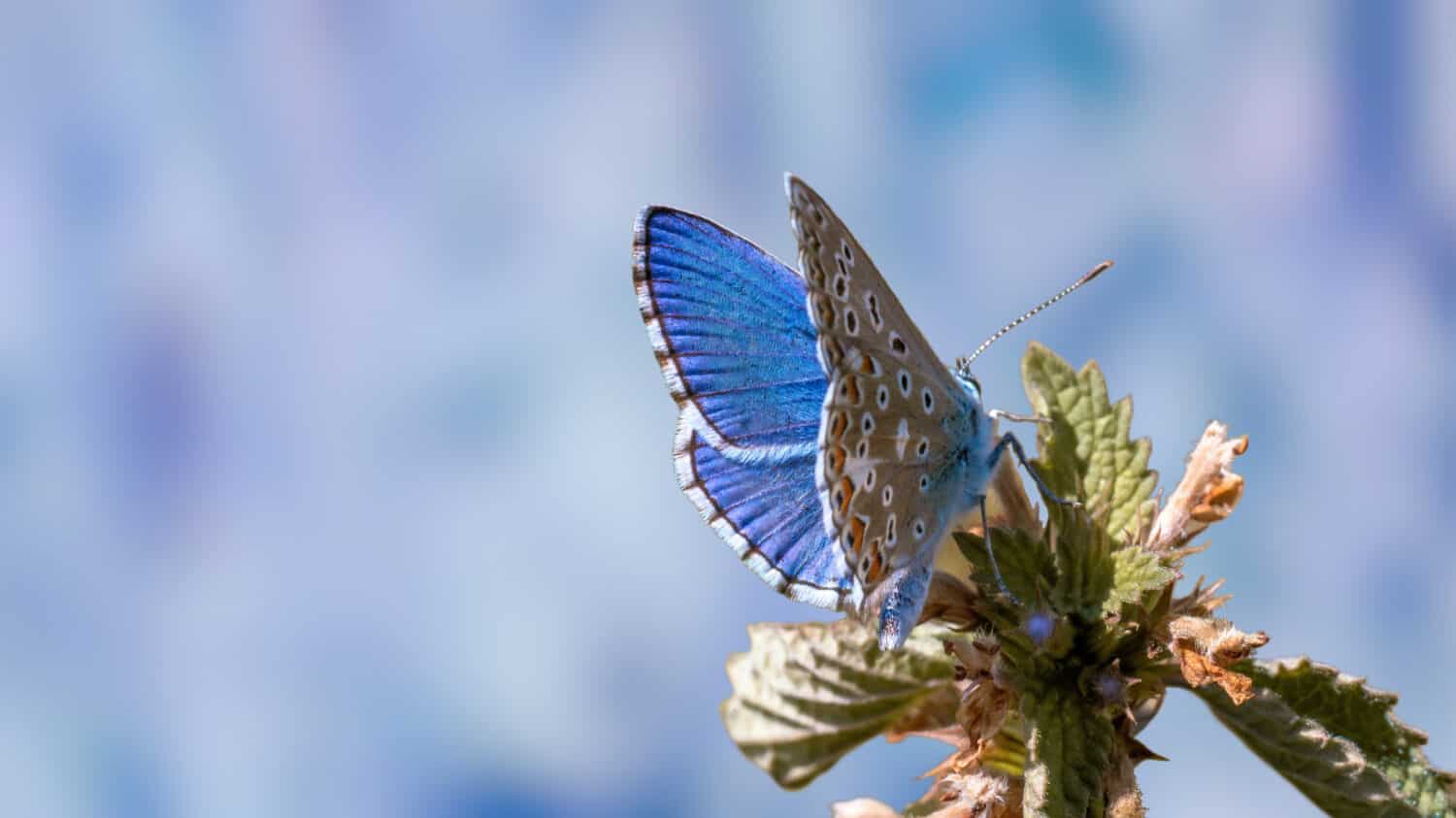
The Adonis blue butterfly cohabitates with ants.
©kakteen/Shutterstock.com
The Adonis blue butterfly is the rarest blue butterfly fluttering around England with a wingspan of almost 1.5 inches. The males are a bright blue or turquoise with black bands on their wings before the white fringe. These markings distinguish them from the common blue, which doesn’t have markings at the end of their wings. However, the female Adonis blue is ironically more often chocolate brown than blue.
Similar to the large blue, Adonis blue butterflies also live with ants. In fact, the ants protect the caterpillars in exchange for the sugar-like substance they produce.
The butterfly species has two broods – one at the end of May and one at the end of August. Females lay their eggs beneath food leaves, where they quickly hatch. They live in the sunny chalk grasslands on steep slopes from May to September. The colony sizes vary from year to year according to the weather. Still, they are hard to spot because they live in concentrated colonies, and their flying patterns are erratic and low, just above the vegetation.
Duke of Burgundy (Hamearis lucina)

The Duke of Burgundy is similar in size to the nail on your thumb.
©Martin Fowler/Shutterstock.com
The Duke of Burgundy is one of the rarest butterflies fluttering around England. The butterflies are small and brown, similar to a fritillary. In fact, they are not much bigger than the nail on your thumb, with a wingspan barely over an inch. The inside of their wings has a row of white spots that stand out against the dark brown and orange on the rest of their bodies.
Duke of Burgundy butterflies live in small colonies on grassland or woodland clearings in isolation in the southern Lake District, North York Moors, and Yorkshire. They rarely fly low enough to visit flowers but will perch on leaves found at the end of scrub to protect their territory. These butterflies are otherwise elusive, especially the females. They spend most of their time resting or laying eggs underneath the leaves of primrose and cowslip plants.
If the weather is warm, they are sometimes spotted as early as April but don’t begin flying until May. By June, they are gone until the following year.
Black-veined White (Aporia crataegi)

The black-veined
white butterfly
was recently spotted for the first time in 100 years.
©doroninanatalie4/Shutterstock.com
The black-veined white became extinct in Britain in 1925. However, the species was recently spotted for the first time in 100 years. The reason for the sighting is unknown, but a BBC reporter spotted the rarest butterfly now fluttering around England between a hawthorn and blackthorn tree.
Outside of England, the black-veined white is widespread across North Africa, Asia, and other parts of Europe. However, worldwide habitat destruction and regular pesticide use are the reason for their general decline. These butterflies were a favorite of Winston Churchill, who believed they were the most beautiful because of their color and unusual flight pattern.
Their wingspan is 2.7 inches to 2.9 inches. The female butterflies rub their wings together, causing their scales to fall off, leaving them mostly see-through. Why the female black-veined white does this is unknown, but it gives them a unique appearance compared to the males. They lived in orchids, gardens, meadows, and anywhere food plants were common.
The photo featured at the top of this post is © doroninanatalie4/Shutterstock.com
Thank you for reading! Have some feedback for us? Contact the AZ Animals editorial team.





